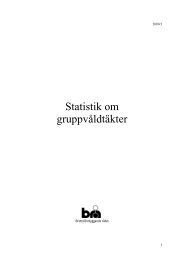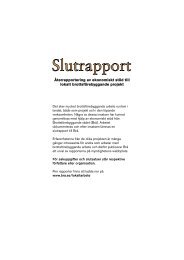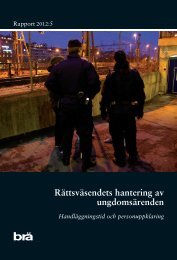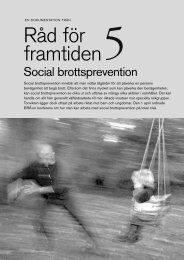The Importance of Place in Policing - Empirical Evidence and Policy ...
The Importance of Place in Policing - Empirical Evidence and Policy ...
The Importance of Place in Policing - Empirical Evidence and Policy ...
Create successful ePaper yourself
Turn your PDF publications into a flip-book with our unique Google optimized e-Paper software.
III. <strong>The</strong> Concentration <strong>of</strong>Crime at <strong>Place</strong>A key requirement for the adoption <strong>of</strong> place-based polic<strong>in</strong>g is thatcrime is heavily concentrated <strong>in</strong> what some have termed “crime hotspots” (Sherman et al., 1989; Sherman & Weisburd, 1995; Weisburd& Green, 1995a). Absent a concentration <strong>of</strong> crime at placethere seems little reason to refocus crime prevention efforts. Indeed,if crime were spread r<strong>and</strong>omly across a city place-based polic<strong>in</strong>gwould provide little benefit.A number <strong>of</strong> studies, beg<strong>in</strong>n<strong>in</strong>g <strong>in</strong> the late 1980s suggest that significantcluster<strong>in</strong>g <strong>of</strong> crime at place exists, regardless <strong>of</strong> the specificunit <strong>of</strong> analysis def<strong>in</strong>ed (see Brant<strong>in</strong>gham & Brant<strong>in</strong>gham, 1999;Crow & Bull, 1975; Pierce, Spaar, & Briggs, 1986; Roncek, 2000;Sherman et al., 1989; Weisburd & Green, 1994; Weisburd, Maher,& Sherman, 1992, Weisburd, Bushway, Lum, & Yang, 2004; Weisburd,Morris, & Gr<strong>of</strong>f, 2009). Perhaps the most <strong>in</strong>fluential <strong>of</strong> thesewas Sherman, Gart<strong>in</strong> <strong>and</strong> Buerger’s (1989) analysis <strong>of</strong> emergencycalls to street addresses over a s<strong>in</strong>gle year. Sherman et al. found thatonly 3 ½ percent <strong>of</strong> the addresses <strong>in</strong> M<strong>in</strong>neapolis, M<strong>in</strong>nesota produced50 percent <strong>of</strong> all calls to the police. <strong>The</strong>y regarded these resultsas so startl<strong>in</strong>g that they called for a new area <strong>of</strong> study whichthey termed the “crim<strong>in</strong>ology <strong>of</strong> place.”Other studies produced similar evidence <strong>of</strong> the concentration <strong>of</strong>crime <strong>in</strong> crime hot spots. Weisburd <strong>and</strong> Mazerolle (2000), for example,found that approximately 20 percent <strong>of</strong> all disorder crimes<strong>and</strong> 14 percent <strong>of</strong> crimes aga<strong>in</strong>st persons were concentrated <strong>in</strong> just56 drug crime hot spots <strong>in</strong> Jersey City, New Jersey, an area thatcomprised only 4.4 percent <strong>of</strong> street segments <strong>and</strong> <strong>in</strong>tersections <strong>in</strong>the city. Similarly, Eck, Gersh, <strong>and</strong> Taylor (2000) found that themost active 10 percent <strong>of</strong> places (<strong>in</strong> terms <strong>of</strong> crime) <strong>in</strong> the Bronx <strong>and</strong>15
















